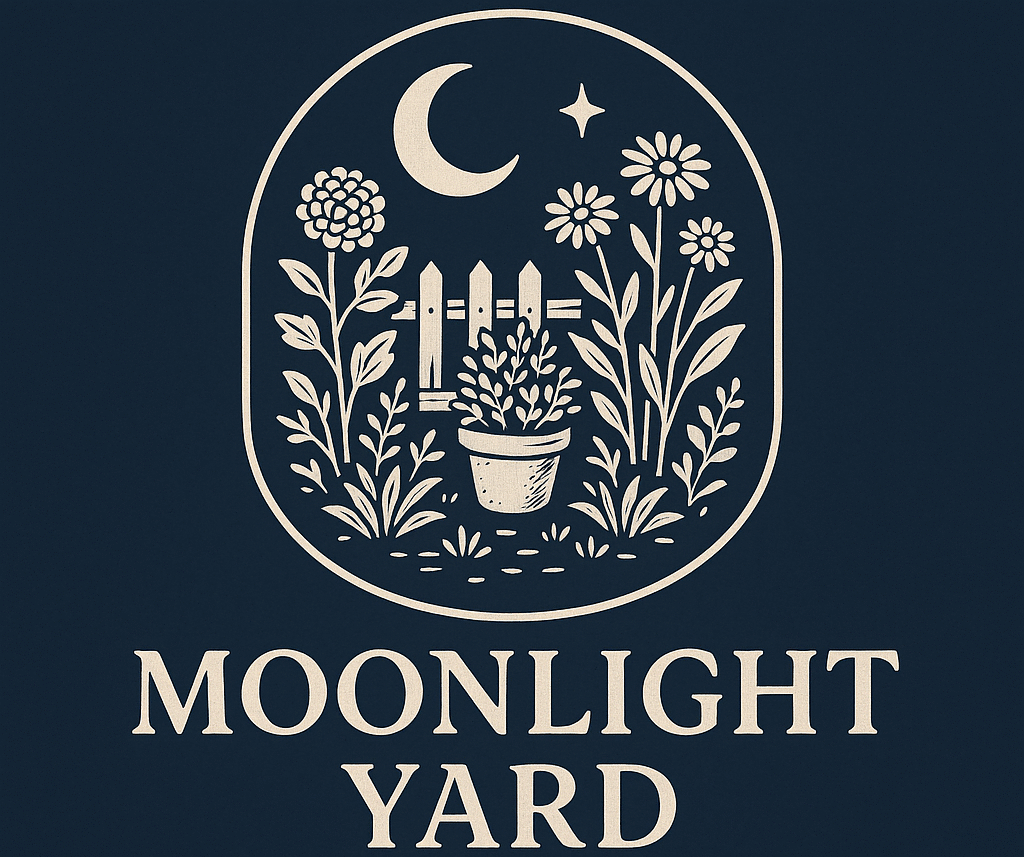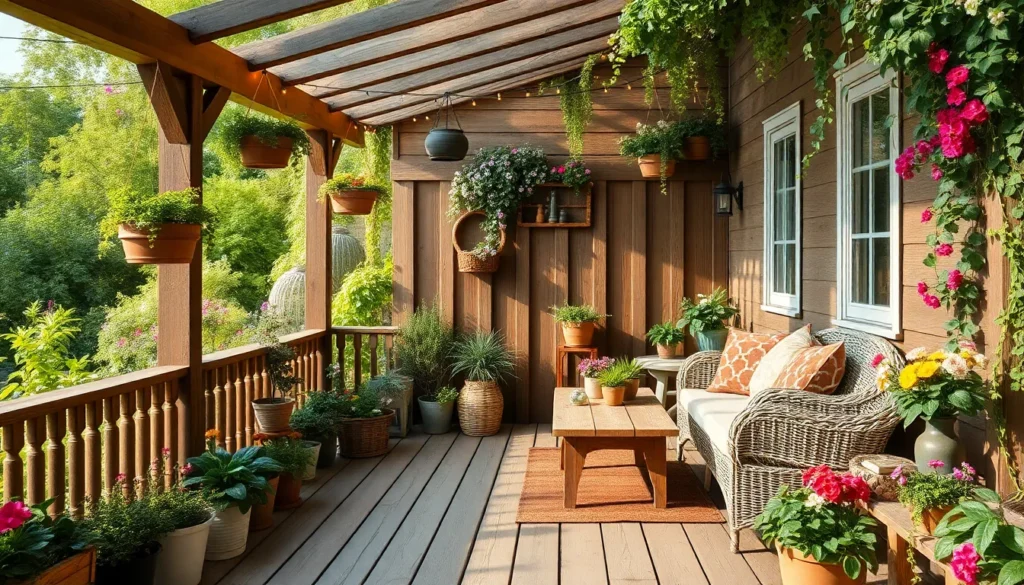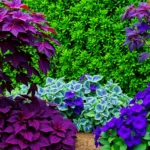Transform your outdoor space into a stunning retreat with garden veranda ideas that blend comfort and natural beauty. We’ve discovered that the perfect veranda creates an seamless connection between your home’s interior and the vibrant garden beyond while providing a peaceful sanctuary for relaxation and entertainment.
Whether you’re working with a sprawling backyard or a cozy corner space, we’ll show you how to design a veranda that reflects your personal style and enhances your property’s value. From rustic wooden decks adorned with climbing vines to modern glass-enclosed spaces that offer year-round garden views, the possibilities are endless.
Our carefully curated collection of garden veranda designs proves that every outdoor space has potential. We’ll explore budget-friendly DIY options alongside luxurious custom builds ensuring you’ll find inspiration that fits your vision and wallet perfectly.
Create a Classic Covered Veranda With Traditional Elements
Traditional elements bring timeless elegance to your garden veranda design while providing essential structural support. We’ll explore authentic materials and classic features that create lasting beauty for your outdoor living space.
Add Wooden Beams and Support Posts
Exposed ceiling beams create the foundational structure that defines a classic covered veranda aesthetic. Cedar and pressure-treated pine offer excellent durability against weather conditions while maintaining their natural wood appearance over time. We recommend spacing beams 16 to 24 inches apart for optimal structural integrity and visual appeal.
Support posts anchor your veranda’s traditional framework and provide essential load-bearing capacity for the roof structure. Round or square wooden columns in 6×6 or 8×8 dimensions work best for most residential applications. Craftsman-style tapered posts add architectural interest while maintaining the classic veranda appearance that complements various home styles.
Natural wood finishes preserve the authentic character of traditional veranda construction methods. Semi-transparent stains in honey oak or weathered gray tones enhance the wood grain while protecting against moisture damage. We suggest applying fresh stain every 2 to 3 years to maintain the wood’s appearance and structural integrity.
Install Classic Railing Designs
Spindle railings provide the quintessential traditional veranda look with vertical balusters spaced evenly between top and bottom rails. Standard spacing of 4 to 6 inches between spindles meets most building codes while creating an elegant appearance. Turned wooden spindles in white or matching wood tones complement the overall veranda design perfectly.
Panel railings offer a more substantial traditional appearance with solid wooden panels between posts and top rails. Raised panel designs add dimensional interest while providing privacy and wind protection for your veranda seating areas. We recommend cedar or composite materials for panel construction to reduce maintenance requirements.
Cross-hatch patterns bring Colonial and Victorian charm to your veranda railing system through intersecting diagonal slats. This traditional design element works especially well on larger verandas where simple spindles might appear too sparse. Painted white or natural wood finishes enhance the classic appeal of cross-hatch railing designs.
Choose Traditional Flooring Materials
Tongue and groove decking provides the authentic foundation for classic veranda construction using interlocking wooden planks. Southern yellow pine and cedar decking boards offer excellent value and weather resistance for traditional outdoor flooring applications. We suggest 5/4-inch thickness for residential verandas to ensure proper structural support and longevity.
Natural stone pavers create elegant flooring surfaces that complement traditional veranda architecture beautifully. Flagstone and bluestone options provide slip-resistant surfaces while maintaining their classic appearance through decades of use. Irregular stone patterns add organic charm that pairs perfectly with wooden veranda elements.
Brick flooring delivers timeless appeal through herringbone and basket weave patterns that enhance traditional garden veranda designs. Clay bricks in red or buff tones create warm, inviting surfaces that age gracefully in outdoor environments. We recommend sealing brick surfaces annually to prevent moisture absorption and maintain their rich color appearance.
Design a Modern Minimalist Veranda Space
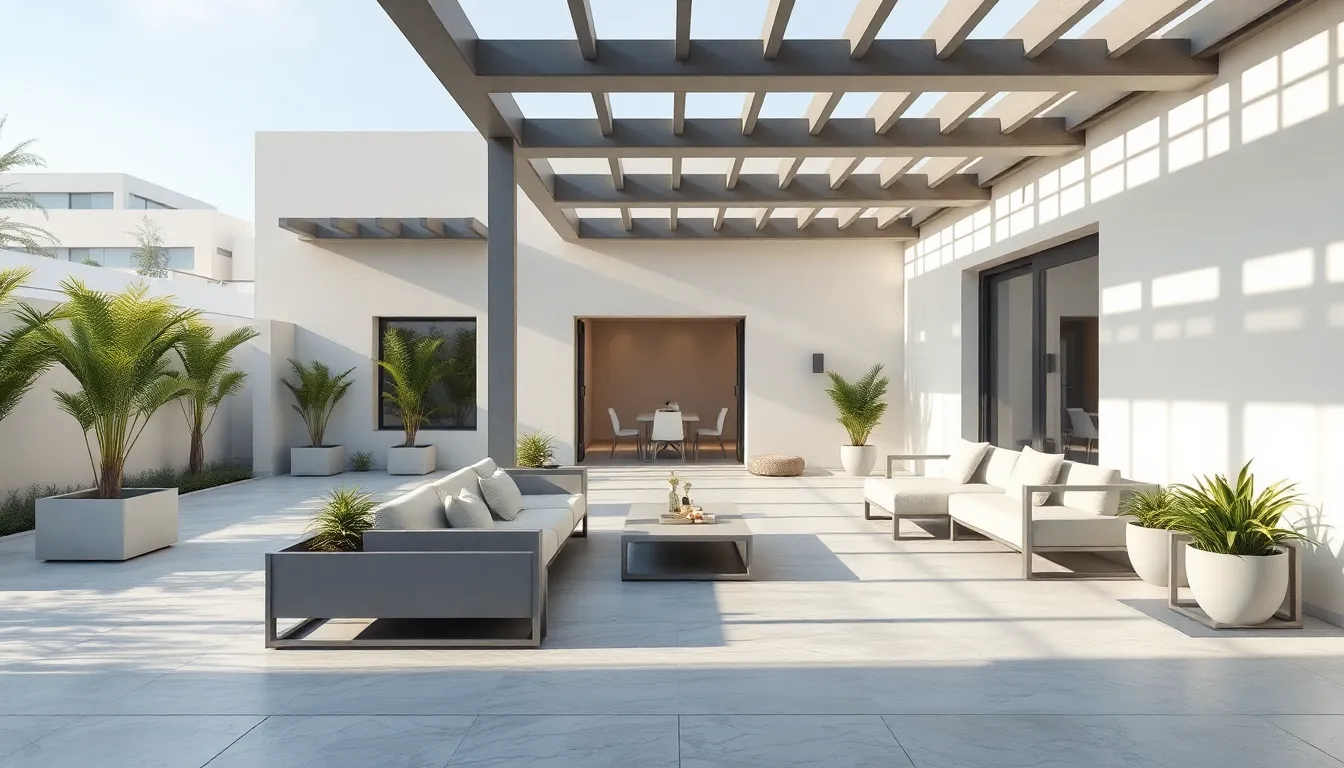
We’ll create a sophisticated outdoor retreat that emphasizes simplicity and functionality. This approach transforms your garden veranda into a serene space perfect for relaxation and entertaining.
Use Clean Lines and Geometric Shapes
Clean lines form the foundation of modern minimalist veranda design, creating visual harmony throughout your outdoor space. We recommend incorporating rectangular planters, linear seating arrangements, and geometric pergola structures to establish this aesthetic. Sharp angles and straight edges eliminate visual clutter while maintaining sophisticated appeal.
Geometric shapes add architectural interest without overwhelming the space’s tranquil atmosphere. Square concrete pavers, circular fire pits, and triangular shade structures create focal points that enhance the overall design. These elements work together to establish a cohesive look that feels both contemporary and timeless.
Symmetrical arrangements amplify the impact of clean geometric forms throughout your veranda space. We suggest positioning matching furniture pieces on opposite sides of the area or creating balanced plantings that mirror each other. This approach reinforces the minimalist principle while adding visual stability to your outdoor retreat.
Select Contemporary Materials Like Steel and Concrete
Steel provides durability and sleek aesthetics that perfectly complement minimalist veranda designs. We choose powder coated steel for furniture frames, railings, and decorative elements because it resists weathering while maintaining its modern appearance. Stainless steel accents add reflective surfaces that enhance natural light throughout the space.
Concrete offers versatility for creating elevated platforms, seating areas, and architectural features. We recommend polished concrete flooring for its smooth finish and easy maintenance requirements. Precast concrete planters and benches provide functional elements that integrate seamlessly with the minimalist aesthetic.
Contemporary materials work best when we combine them strategically throughout the veranda design. Steel pergola frames paired with concrete columns create structural interest while maintaining the clean lines essential to minimalist style. These material combinations ensure your veranda remains both beautiful and functional for years to come.
Incorporate Neutral Color Palettes
Neutral colors create the calm atmosphere essential to successful minimalist veranda designs. We select light gray, white, and beige as our primary palette because these shades reflect natural light and maintain visual continuity. Soft taupe and warm cream tones add subtle variation without disrupting the serene environment.
Monochromatic schemes using different shades of the same neutral color create depth and sophistication. We layer various gray tones from charcoal steel frames to light concrete surfaces for visual interest. This approach maintains the minimalist aesthetic while preventing the space from appearing flat or monotonous.
Strategic color placement enhances the natural beauty of your garden veranda without overwhelming the senses. We recommend using darker neutrals for structural elements and lighter shades for surfaces and textiles. This balance creates visual hierarchy while preserving the peaceful atmosphere that makes minimalist design so appealing.
Build a Rustic Country-Style Garden Veranda
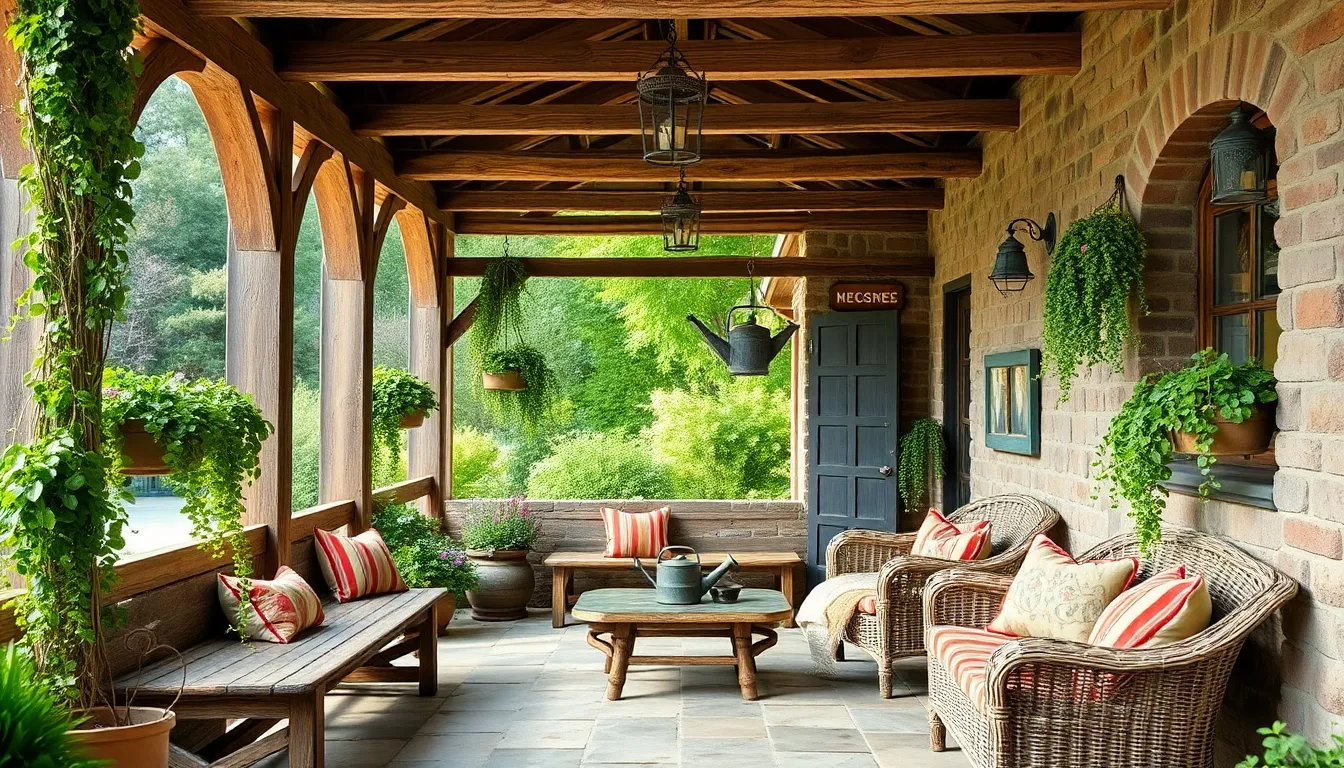
Creating a rustic country-style garden veranda transforms your outdoor space into a charming retreat that celebrates natural beauty and vintage character. We’ll guide you through incorporating authentic materials and timeless design elements that create a cozy, welcoming atmosphere.
Feature Natural Wood and Stone Elements
Reclaimed wood serves as the foundation for achieving an authentic rustic aesthetic in your veranda design. We recommend using distressed or weathered timber for structural elements like support beams, railings, and flooring to create that coveted aged appearance. Salvaged barn wood, driftwood, or repurposed fence boards add character while supporting sustainable building practices.
Stone features complement wooden elements by introducing natural texture and earthy tones to your veranda space. Consider incorporating fieldstone walls, flagstone pathways, or river rock accents that blend seamlessly with the surrounding industry. These materials create visual contrast against wooden surfaces while maintaining the organic feel essential to country design.
Natural wood finishes enhance the rustic charm when you choose stains that highlight the wood’s grain rather than concealing it. Cedar, pine, and oak work exceptionally well for veranda construction due to their durability and natural weather resistance. Allow the wood to gray naturally over time, or apply a light stain that preserves the material’s authentic character.
Add Vintage Accessories and Decor
Antique watering cans create focal points when displayed alongside your favorite plants or positioned as standalone decorative elements. We suggest hunting for galvanized metal pieces, copper vessels, or enamelware containers at flea markets and antique shops. These functional accessories tell stories while adding authentic vintage appeal to your veranda setting.
Rustic signage brings personality to your country veranda through weathered wood signs, vintage farm advertisements, or hand painted messages. Mount these pieces on posts, walls, or lean them against railings for casual charm. Old milk cans, grain buckets, and mason jars serve as unique planters that reinforce the farmhouse aesthetic.
Galvanized metal planters showcase herbs and flowers while maintaining the authentic country garden feel. Fill these containers with aromatic plants like lavender, rosemary, or thyme that provide both visual interest and natural fragrance. Wooden crates and old barrels also function as excellent planters when lined with proper drainage materials.
Include Comfortable Farmhouse Furniture
Distressed wood benches provide seating that perfectly complements the rustic veranda theme while offering durability for outdoor use. Look for pieces with visible wear patterns, chipped paint, or natural weathering that adds authentic character. These benches work beautifully paired with colorful cushions or vintage quilts for added comfort.
Wicker furniture introduces texture through natural materials that align with country design principles. Choose pieces with deep cushions covered in weather resistant fabrics featuring florals, checks, or solid earth tones. Wicker sofas and chairs create intimate conversation areas perfect for afternoon tea or evening relaxation.
Rustic dining tables encourage outdoor meals when paired with mismatched wooden chairs that add eclectic charm to your veranda space. We recommend choosing a sturdy farm table or repurposing an old door as a tabletop for authentic appeal. Decorate with mason jar centerpieces filled with wildflowers and vintage tableware to complete the country dining experience.
Hanging planters add vertical interest through macramé holders, metal brackets, or rope suspended containers filled with trailing plants like ivy or ferns. These elevated garden elements maximize growing space while creating layers of greenery that soften hard surfaces. String lights woven between hanging plants create magical ambiance for evening gatherings throughout the seasons.
Incorporate Lush Greenery and Plant Features
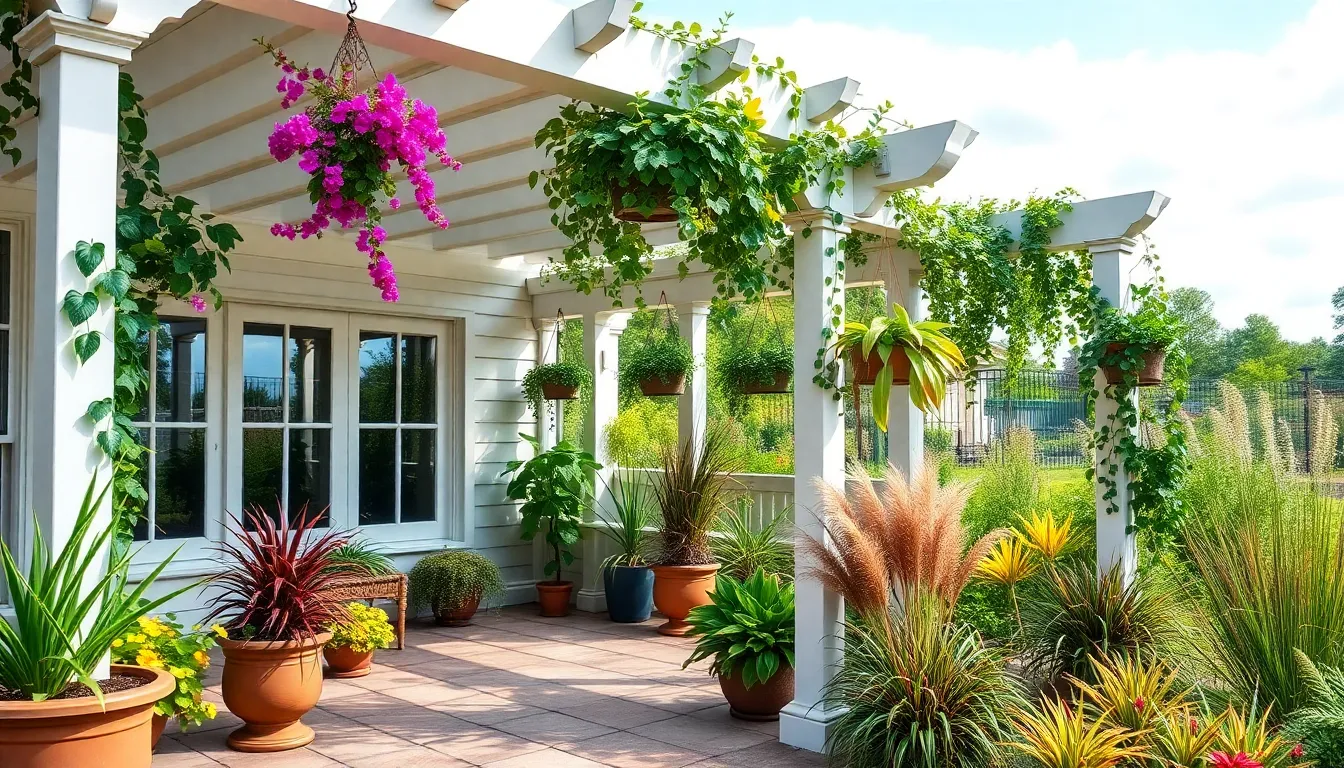
Now we’ll transform your veranda into a verdant sanctuary by thoughtfully integrating plants that bring life and natural beauty to your outdoor retreat.
Install Built-In Planters and Garden Beds
Built-in planters create seamless integration between your veranda structure and living elements. We recommend incorporating these planters directly into the veranda’s framework for a polished, cohesive appearance that eliminates the need for separate containers.
Raised garden beds offer versatility when ground planting isn’t feasible on your veranda surface. These elevated growing spaces provide excellent drainage while creating defined areas for your favorite plants and herbs.
Planning your built-in features during the initial construction phase ensures proper water drainage and structural support. We suggest consulting with contractors to integrate plumbing connections for easy watering access.
Add Climbing Vines and Vertical Gardens
Trellises provide excellent support structures for climbing vines that deliver vertical color and natural shade coverage. We recommend installing sturdy wooden or metal trellises along veranda walls to maximize your growing space while creating privacy screens.
Vertical landscaping transforms blank walls into living artworks using wall-mounted planters and modular growing systems. These space-saving displays work particularly well on smaller verandas where floor space is limited.
Columnar evergreens like Italian Cypress or Sky Pencil Holly create dramatic vertical elements while providing year-round privacy screening. We suggest positioning these slender trees strategically to block unwanted views without overwhelming your veranda space.
Create Hanging Plant Displays
Hanging baskets suspended from veranda ceilings add visual interest from above while keeping floor space clear for furniture and foot traffic. We recommend using chains or decorative hangers that complement your veranda’s overall design aesthetic.
Macramé plant hangers bring bohemian charm to your outdoor space while showcasing trailing plants like petunias or ivy. These decorative holders work especially well when grouped at varying heights for ever-changing visual appeal.
Ornamental grasses such as Dwarf Fountain Grass or Elk Blue California Gray Rush provide excellent hanging options for quick space filling with gentle motion and light screening effects. We suggest combining these with scented herbs and flowers to enhance your veranda’s ambiance with natural fragrance.
Install Comfortable Seating and Dining Areas
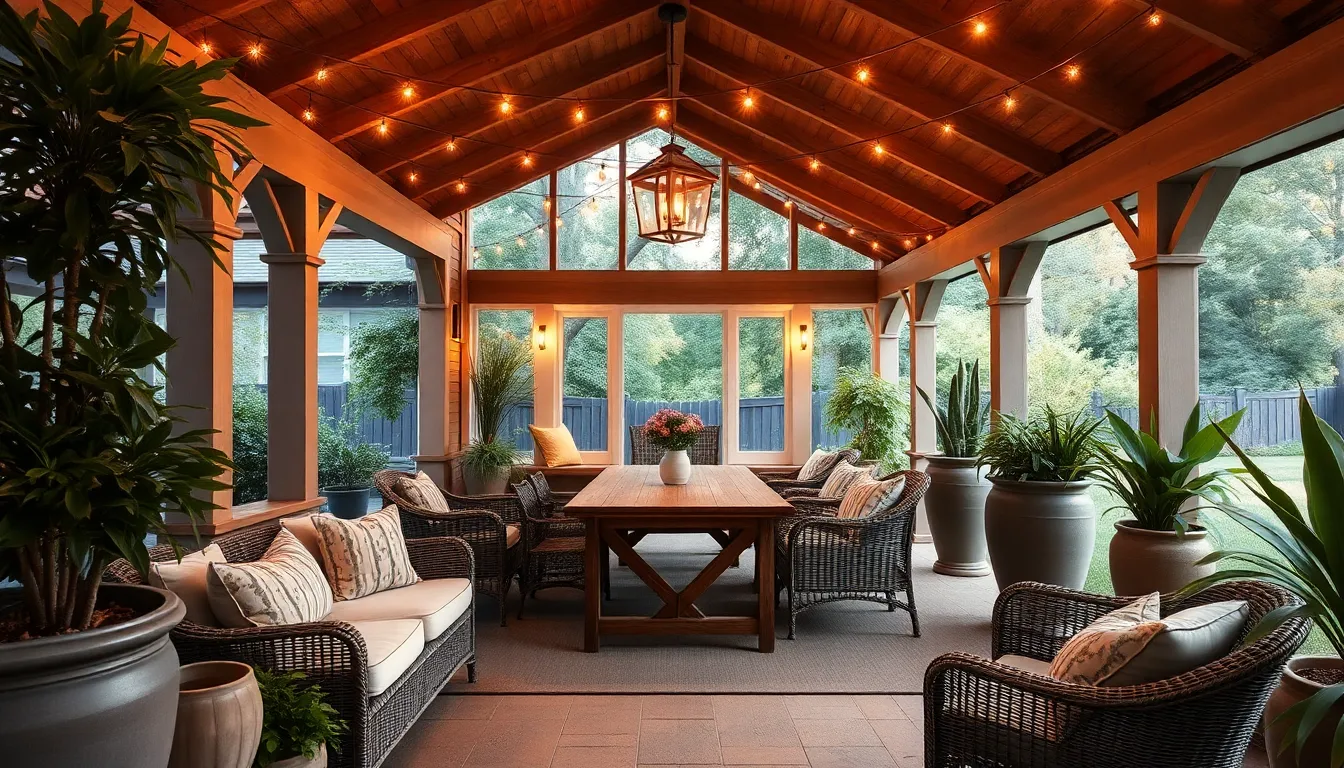
Creating a functional and inviting outdoor space requires careful selection of furniture and thoughtful arrangement of different zones. We’ll explore how to establish comfortable areas that serve multiple purposes while maintaining weather resistance and style.
Choose Weather-Resistant Outdoor Furniture
Selecting durable materials forms the foundation of any successful veranda design. We recommend prioritizing furniture frames made from teak, cedar, or stainless steel, as these materials withstand harsh weather conditions while maintaining their structural integrity over time.
Weather-resistant outdoor furniture options include wicker, rattan, and recycled plastic pieces that combine durability with aesthetic appeal. These materials resist fading, cracking, and moisture damage that typically plague inferior outdoor furniture selections.
Upholstery choices significantly impact both comfort and longevity of your seating arrangements. We suggest investing in water-resistant fabrics for cushions and pillows, ensuring they’ll maintain their appearance and comfort throughout multiple seasons of use.
Adding plush textiles enhances comfort without compromising weather resistance. Incorporate cushions and pillows made from water-resistant materials that provide the softness you want while standing up to outdoor conditions.
Create Intimate Conversation Nooks
Large planters serve dual purposes by defining conversation areas while introducing lush greenery to your outdoor space. We position these strategically to create natural boundaries between different functional zones on the veranda.
Soft lighting transforms ordinary spaces into cozy gathering spots perfect for evening conversations. Install string lights or lanterns to create ambient lighting that encourages intimate discussions and extends the usable hours of your outdoor retreat.
Strategic furniture placement helps establish conversation clusters that feel separate from dining or activity areas. We arrange seating in circular or L-shaped configurations that naturally encourage face-to-face interaction among guests.
Design Al Fresco Dining Spaces
Natural elements create authentic outdoor dining experiences that connect you with your garden environment. Incorporate stone or reclaimed wood for dining tables, materials that complement the natural setting while providing sturdy surfaces for meals and gatherings.
Outdoor rugs define dining zones while adding comfort underfoot and visual interest to hard surfaces like concrete or decking. We select weather-resistant options that can handle spills and moisture while maintaining their appearance.
Decorative elements enhance the dining atmosphere beyond basic functionality. Add wind chimes or sculptures to create sensory interest that makes outdoor meals more memorable and captivating for guests.
Vertical space utilization through hanging planters or trellises creates a lush backdrop for dining areas. We recommend using these features to establish privacy and natural beauty that enhances the overall dining experience.
Add Lighting Solutions for Evening Ambiance
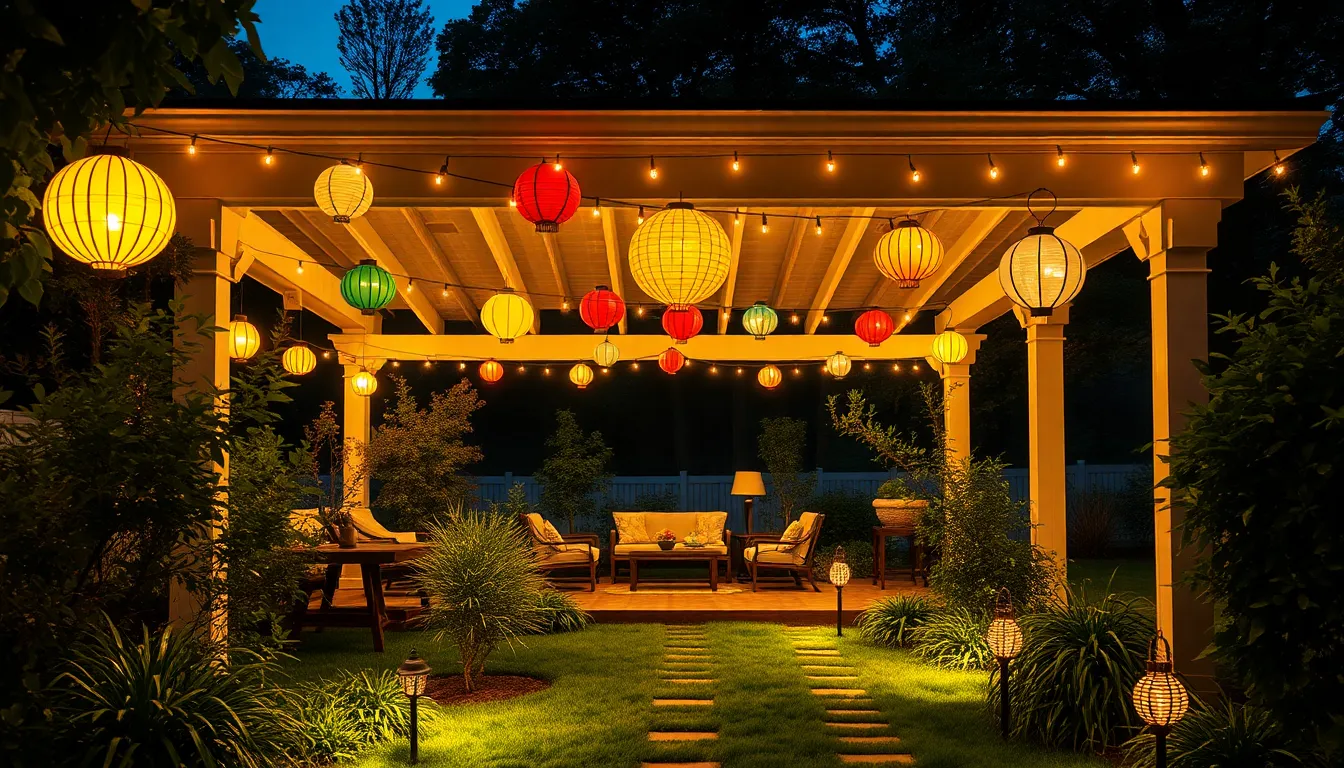
Transform your garden veranda into a magical nighttime retreat with carefully planned lighting that extends your outdoor enjoyment well past sunset. Strategic illumination creates warmth and ambiance while ensuring safety for evening entertaining.
Install String Lights and Lanterns
String lights offer the most versatile way to add instant charm to any veranda space. We recommend installing café style bulbs along the roofline or wrapping them around support posts to create overhead canopies of light. Edison bulb strings provide vintage appeal while LED versions offer energy efficiency and longer lifespan.
Lanterns complement string lighting by adding focal points throughout the space. Hang paper lanterns at varying heights to create visual depth, or place traditional metal lanterns on tables and floor surfaces. Japanese style lanterns work particularly well in Asian inspired verandas, while rustic tin lanterns enhance country themed spaces.
Mix different sizes and styles to avoid monotony in your lighting design. Large statement lanterns can anchor seating areas while smaller accent pieces fill gaps between major light sources. Battery operated options provide flexibility for placement without electrical constraints.
Use Solar-Powered Garden Lighting
Solar powered fixtures eliminate the need for complex wiring while reducing environmental impact through renewable energy. Modern solar technology offers bright illumination that rivals traditional electric lighting options. We’ve found that quality solar lights can provide 6-8 hours of consistent lighting after a full day of charging.
Place solar path lights along walkways leading to your veranda to create safe navigation routes. Solar spotlights can highlight architectural features like columns or decorative planters while solar string lights offer the same ambiance as plug in versions. Many solar fixtures include automatic sensors that turn lights on at dusk and off at dawn.
Choose solar lights with removable batteries for winter storage in colder climates. Higher end models feature adjustable solar panels that can be positioned for optimal sun exposure even when the light fixture is placed in shadier areas.
Incorporate Built-In LED Features
Built-in LED lighting provides permanent illumination answers that integrate seamlessly with your veranda design. Install LED strip lights under railings to create subtle safety lighting that won’t overwhelm the space. Recessed LED fixtures in overhead beams offer downward lighting for dining and conversation areas.
Step lighting becomes essential for multi level verandas where safety concerns require consistent visibility. LED strips under each step edge provide clear definition without harsh glare. We recommend warm white LEDs (2700K-3000K) for cozy ambiance rather than cool white options that can feel clinical.
Consider smart LED systems that allow dimming and color temperature adjustments through smartphone apps. These systems can be programmed to automatically adjust throughout the evening, starting bright during dinner and dimming as the night progresses. Waterproof ratings of IP65 or higher ensure longevity in outdoor conditions.
Create Privacy With Natural and Artificial Screens
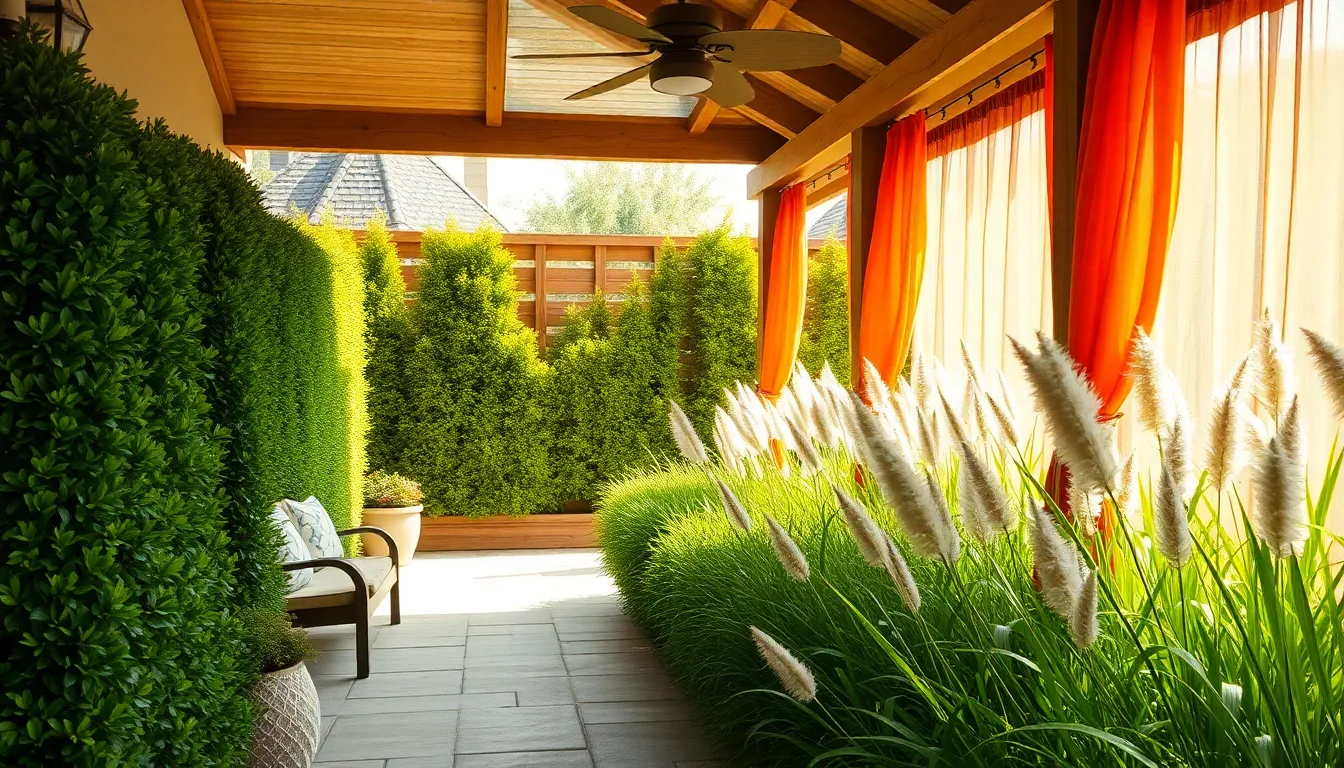
Privacy transforms your garden veranda into a personal sanctuary where you can relax without feeling exposed. We’ll explore natural and artificial screening answers that enhance both seclusion and visual appeal.
Plant Strategic Hedges and Shrubs
Boxwood hedges create dense living walls that effectively block unwanted views while adding year-round greenery to your veranda perimeter. These versatile plants maintain their compact shape with minimal pruning and provide consistent coverage throughout the seasons.
Arborvitae varieties offer excellent height and density for maximum privacy screening around outdoor spaces. Their naturally columnar growth pattern makes them ideal for creating uniform barriers without extensive maintenance requirements.
Bamboo screening delivers rapid coverage with its fast-growing nature and creates an exotic backdrop for your veranda retreat. Different bamboo species provide varying heights and densities to match your exact privacy needs.
Palm trees establish quick vertical coverage while adding tropical flair to your outdoor sanctuary. Fast-growing varieties like Areca palms or Bamboo palms create effective natural screens within just a few growing seasons.
Ornamental grasses form soft barriers that provide privacy while allowing gentle movement and airflow around your veranda space. Tall varieties like fountain grass or miscanthus create flowing screens that enhance the natural ambiance.
Install Decorative Privacy Panels
Wooden privacy screens offer versatile answers with slatted designs that block sightlines while maintaining airflow and filtered light penetration. Cedar and teak panels provide natural weather resistance and complement organic garden aesthetics beautifully.
Vinyl privacy panels deliver maintenance-free screening with consistent appearance and long-lasting durability against harsh weather conditions. These panels come in various heights and decorative patterns to match different veranda styles.
Metal screening options include powder-coated aluminum and steel panels that provide contemporary privacy answers with minimal upkeep requirements. Geometric patterns and perforated designs offer modern appeal while maintaining functional privacy coverage.
Composite materials combine durability with aesthetic flexibility through wood-grain textures and various color options that resist fading and weathering. These panels integrate seamlessly with both traditional and contemporary veranda designs.
Latticework panels create decorative barriers that support climbing plants while providing immediate privacy coverage for your outdoor retreat. Ready-made lattice screens offer quick installation answers that can be customized through DIY modifications.
Use Outdoor Curtains and Drapes
Weather-resistant fabric panels hung from pergola frames create flexible privacy barriers that adjust to your immediate needs and preferences. These drapes can be drawn closed for complete seclusion or opened to enjoy panoramic garden views.
Outdoor curtain systems provide both functional privacy and aesthetic enhancement through coordinated colors and patterns that complement your veranda’s design theme. Installation hardware designed for exterior use ensures reliable operation throughout different weather conditions.
Retractable drapery options offer maximum versatility by allowing you to control privacy levels throughout the day based on activities and weather. These systems integrate with existing veranda structures without requiring extensive modifications.
Waterproof curtain materials maintain their appearance and functionality through rain exposure and humidity while providing consistent privacy coverage. Solution-dyed acrylic fabrics resist fading and mildew while offering easy cleaning maintenance.
Combination screening approaches maximize privacy effectiveness by integrating hedges with decorative panels or curtains with natural plantings. These layered answers create comprehensive barriers that enhance both privacy and garden beauty simultaneously.
Enhance With Decorative Elements and Accessories
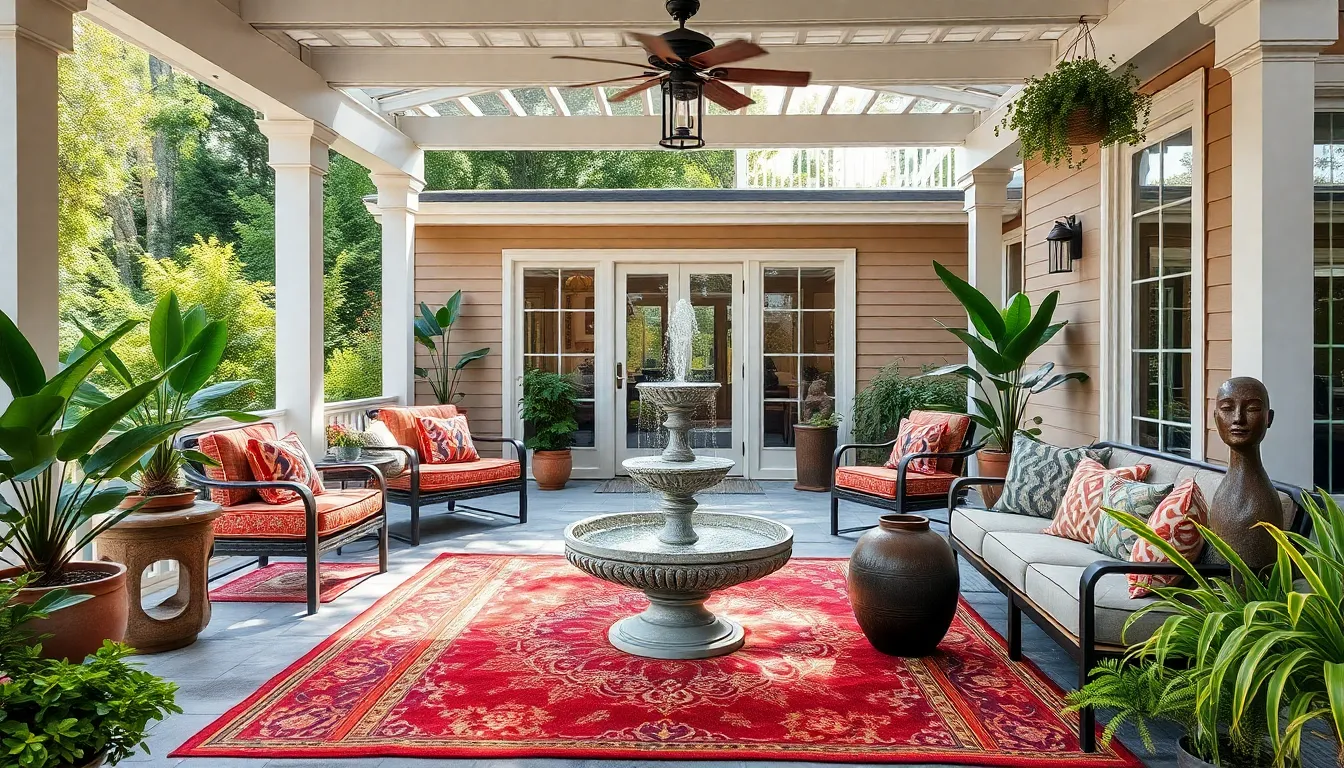
Once we’ve established privacy and beautiful lighting in our garden veranda, we can focus on adding finishing touches that make the space truly exceptional. These decorative elements create visual interest and transform an ordinary outdoor area into a stunning retreat.
Add Outdoor Rugs and Textiles
Outdoor rugs instantly warm up concrete or wooden flooring while defining different areas within our veranda space. We recommend choosing materials that are durable and water-resistant to withstand moisture and temperature changes throughout the seasons. Polypropylene and solution-dyed acrylic fabrics offer excellent weather resistance while maintaining vibrant colors and soft textures underfoot.
Textiles like throws and cushions add comfort and style to our outdoor furniture arrangements. Weather-resistant fabrics in natural tones complement both rustic and modern veranda designs perfectly. Waterproof cushion covers protect our investment while allowing us to change colors seasonally without worry.
Strategic placement of outdoor rugs helps create distinct zones for dining, lounging, and conversation areas. Large area rugs anchor seating groups while smaller accent rugs highlight exact furniture pieces or decorative displays.
Include Water Features and Fountains
Water features bring tranquility and natural sounds that mask nearby traffic or neighborhood noise effectively. Small ponds integrated into built-in planters create focal points while supporting aquatic plants and attracting beneficial wildlife to our garden veranda. These features require minimal maintenance when properly designed with adequate filtration systems.
Fountains offer versatility in both size and style, from tabletop versions perfect for intimate settings to larger statement pieces that anchor entire veranda designs. Wall-mounted fountains save floor space while providing the same soothing water sounds and visual appeal as freestanding options.
Solar-powered water features eliminate electrical requirements while operating sustainably throughout daylight hours. Battery backup systems ensure continuous operation during cloudy periods, maintaining the peaceful atmosphere we’ve created.
Display Garden Art and Sculptures
Garden art adds personality and reflects our individual style preferences within the carefully designed veranda environment. Sculptures made from natural materials like stone, ceramic, or weather-treated metal complement planted areas while creating visual anchors throughout the space. These pieces should harmonize with our chosen design theme rather than compete with natural elements.
Mosaic art incorporating colors from our plant palette creates cohesive visual connections between hardscape and industry elements. Wall-mounted pieces maximize floor space while vertical sculptures draw the eye upward, improving the perceived height of covered areas.
Rotating seasonal art displays keep our veranda fresh and interesting throughout the year. Lightweight pieces allow for easy rearrangement, while permanent installations provide stability and long-term visual impact that grows more beautiful as plants mature around them.
Consider Seasonal Adaptations and Weather Protection
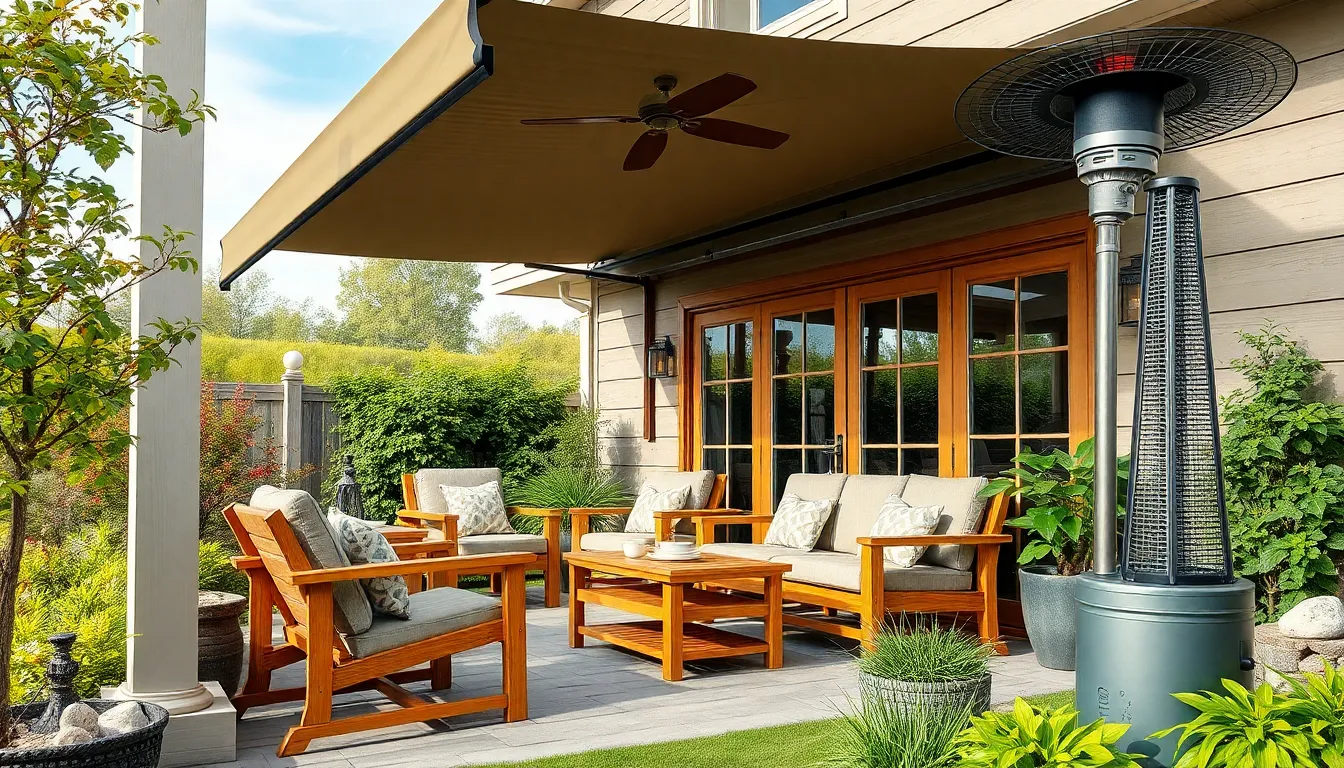
We can extend our garden veranda’s usability throughout the year by implementing strategic adaptations that protect against changing weather conditions. These essential modifications ensure we’ll enjoy our outdoor retreat regardless of the season.
Install Retractable Awnings or Pergolas
Retractable awnings offer exceptional versatility by providing shade during warmer months while allowing us to retract them for sunlight during cooler seasons. We’ll benefit from their dual protection against both rain and wind, ensuring our veranda remains functional year-round. Pergolas equipped with retractable canopies give us similar flexibility while adding architectural interest to our outdoor space.
Installing these structures requires careful consideration of our veranda’s size and orientation. We should position retractable systems to maximize coverage during peak sun hours while maintaining easy operation mechanisms. Motor-driven options provide convenient one-touch control, while manual systems offer reliable backup functionality.
Add Heating Elements for Cooler Months
Heating elements transform our veranda into a cozy retreat that extends well into cooler seasons. Infrared heaters provide efficient warmth without requiring extensive installation, while fire pits create focal points that encourage gathering and conversation. We can choose from wall-mounted units, freestanding models, or built-in fire features depending on our space and budget.
Strategic placement ensures optimal heat distribution while maintaining safety clearances from furniture and plants. Electric options offer instant warmth and precise temperature control, while gas-powered alternatives provide authentic ambiance with consistent heat output. Portable heating answers give us flexibility to adjust our setup based on seasonal needs.
Choose Durable All-Weather Materials
Durable materials form the foundation of our weather-resistant veranda design. Cedar and teak woods naturally resist moisture, insects, and temperature fluctuations while developing attractive patinas over time. Weather-resistant fabrics maintain their appearance and functionality even though exposure to sun, rain, and wind.
Hardy plants complement our material choices by thriving in various weather conditions without requiring extensive maintenance. We should select furnishings made from aluminum, stainless steel, or synthetic materials that won’t rust, crack, or fade. Stone and ceramic elements add natural beauty while withstanding freeze-thaw cycles and UV exposure.
Quality construction materials represent smart long-term investments that reduce replacement costs and maintenance requirements. We’ll enjoy consistent performance and appearance when we prioritize materials specifically engineered for outdoor environments.
Conclusion
Creating our perfect garden veranda doesn’t have to be overwhelming when we break it down into manageable elements. Whether we’re drawn to rustic charm or sleek modern aesthetics we’ve got countless options to bring our vision to life.
The key lies in balancing functionality with beauty while staying true to our personal style and budget. From selecting the right materials to incorporating thoughtful lighting and privacy answers each decision contributes to our overall outdoor sanctuary.
Remember that our garden veranda should evolve with our needs and the changing seasons. By investing in quality weather-resistant elements and flexible design features we’ll create an outdoor space that brings joy year-round.
Start with one element that excites you most and build from there – your dream garden veranda is closer than you think.
Frequently Asked Questions
What is a garden veranda and how does it enhance outdoor living?
A garden veranda is a covered outdoor space that seamlessly connects your home to your garden, creating a peaceful retreat for relaxation and entertainment. It enhances outdoor living by providing a comfortable, sheltered area where you can enjoy nature while being protected from the elements, effectively extending your living space outdoors.
What are the main design styles for garden verandas?
The main design styles include classic covered verandas with traditional wooden elements and exposed beams, modern minimalist spaces featuring clean lines and geometric shapes, and rustic country-style verandas using reclaimed wood and vintage accessories. Each style offers unique aesthetic appeal and can be adapted to different budgets and personal preferences.
What materials work best for veranda construction?
Durable materials like cedar, teak, and stainless steel are ideal for their weather resistance. For flooring, consider tongue and groove decking, natural stone pavers, or polished concrete. Modern designs benefit from steel and concrete, while rustic styles work well with reclaimed wood and natural stone elements.
How can I create privacy on my garden veranda?
Create privacy using strategic plantings like boxwood hedges, bamboo, or ornamental grasses for natural barriers. Decorative panels made from wood, vinyl, or metal offer low-maintenance solutions. Outdoor curtains provide flexible coverage, while combination approaches using hedges with panels create comprehensive privacy screens that enhance both seclusion and garden beauty.
What plants work best for veranda gardens?
Choose columnar evergreens for privacy screens, ornamental grasses for gentle movement, and climbing vines for vertical coverage. Install built-in planters and raised garden beds for seamless integration. Hanging planters maximize space while keeping floors clear, and vertical gardens create living walls that enhance privacy and visual appeal.
How do I choose weather-resistant furniture for my veranda?
Select furniture made from durable materials like teak, cedar, wicker, rattan, or recycled plastic that can withstand harsh weather conditions. Choose water-resistant upholstery for cushions and pillows to maintain comfort and appearance. Stainless steel components add durability, while powder-coated finishes provide additional weather protection.
What lighting options work best for evening veranda use?
String lights and lanterns create warmth and charm for evening gatherings. Solar-powered garden lighting offers eco-friendly illumination with easy installation. Built-in LED features provide permanent lighting that integrates seamlessly with your design. Smart LED systems allow customizable lighting experiences while ensuring safety and enhancing the overall ambiance.
How can I extend my veranda’s usability throughout the seasons?
Install retractable awnings or pergolas for shade and rain protection. Add heating elements like infrared heaters or fire pits to create warmth during cooler months. Choose all-weather materials that withstand seasonal changes, and consider seasonal decorative displays to maintain visual interest year-round while adapting to different weather conditions.
What decorative elements enhance a garden veranda’s appeal?
Add outdoor rugs and weather-resistant textiles to define spaces and add warmth. Incorporate water features like small fountains for tranquility and visual appeal. Garden art and sculptures reflect personal style, while seasonal displays provide variety. Throws and cushions in weather-resistant fabrics add comfort and color to the space.
What’s the typical budget range for creating a garden veranda?
Garden veranda costs vary widely depending on size, materials, and complexity. Budget-friendly DIY projects can start from a few hundred dollars using basic materials and simple designs. Mid-range projects typically cost several thousand dollars, while luxurious custom builds with premium materials and professional installation can reach tens of thousands of dollars.
